When most people daydream about Indonesian travel, their minds often wander to the rice fields of Bali, the sea life of Flores and the scaly beasts of Komodo. However, I’m here today to propose the incredible travel potential found in Sumatra. This is the country’s largest fully-Indonesian island (they share big ol’ Borneo with Malaysia), and it is an excellent place to explore. Moreover, with it’s proximity to Peninsular Malaysia, flights to and from Sumatra are often shorter, more frequent, and more affordable than elsewhere in Indonesia.
Why Sumatra?
Every island in the Indonesian archipelago has its own aboriginal cultures and sprawling biodiversity. Sumatra, however, is unique in that its flora and fauna are some of the most diverse on the planet, yet still remarkably accessible to curious travelers like you and I. Tigers, tapirs, rhinos, and orangutans call this island home, and while their territories are shrinking at an alarming rate, there are still responsible tourism opportunities to help you witness these creatures in their natural habitat. In addition to wildlife, Sumatra has lush jungles, clear rivers, imposing volcanoes and soothing hot springs that are worth exploring.
[box]Other articles you can read:
- 7 Awesome Things to Do in Bali, Indonesia
- How to Enjoy Bandung, Indonesia in a Weekend?
- 7 Awesome Things to Do in Bali, Indonesia
- 7 Awesome Things to Do in Yogyakarta, Indonesia
- 7 Awesome Things to Do in Ubud, Bali, Indonesia
[/box]
Our family enjoyed Northern Sumatra so much, in fact, that we returned for a second helping less than six months later. We were based in Penang, Malaysia at the time, and flights from here to North Sumatra’s capital of Medan are cheap and less than an hour. From Medan, the journey gets rocky, but it’s worth every bump on the road.
My seven recommendations below are all found in or near the Northern Sumatran towns of Bukit Lawang and Berastagi. We have driven cars, motorcycles, and scooters in much of Southeast Asia, but in Sumatra, we chose to hire a driver in Sumatra, and very glad we did. For less than USD $50, hotels in Bukit Lawang arranged pickup at the Medan Airport and passage along the (occasionally paved) roads to our accommodation. This journey takes about three to four hours, depending on stops for food and toilet breaks. The costs were even less in Berastagi where we hired a local driver for the day.
Here are 7 Awesome Things to Do in Northern Sumatra, Indonesia
1. Go Jungle Trekking in Gunung Leuser National Park
Lizards, peacocks, and monkeys, oh my! The Gunung Leuser National Park is full of wildlife, and if you spend a day hiking through her interior, you are very likely to encounter some of the inhabitants. We saw wild peacocks, massive monitor lizards, and numerous species of monkey, including the calm and curious Thomas Leaf Monkeys, which seemed to watch our hike with genuine interest. Tapirs, elephants, and rhinos call this park home, as well.

The true stars of Gunung Leuser National Park, however, are its orangutan population. There are less than 7000 orangutans left in the wild, and they’re only found in Borneo and Sumatra. With their numbers dwindling worldwide, it was a special privilege for our kids to see them in the wild. Regularly scheduled feedings happen near the rehabilitation center near the river, but with a skilled guide to help, you can find them during a hike in the park.

You’ll find guides in Bukit Lawang, a small town that hugs the river at the edge of the park. Trips range from a half-day up to multiple days in the bush, camping in the jungle with guides as you go. We chose half-day treks with our 9- and 12-year olds, and while the trails are not an easy stroll, all four of us managed them on both trips. We saw nearly a dozen orangutans over those two treks, including huge males and adorable babies. Our tours came with lunch, which was nasi goreng (Indonesian-style fried rice) wrapped in a leaf and freshly cut pineapple.
2. Explore Gua Kampret and other caves near Bukit Lawang
Find the path near Bukit Lawang’s Ecolodge and follow the signs towards the “Bat Cave.” Soon you’ll arrive at a small trail that leads to the caves. Often, the landowners sit near the entrance requesting a small fee. When we last visited, they also offered to guide us.

I was hesitant at first, but in the end was glad that they joined us because the caves were much larger than we had first predicted. The smell of guano (bat poo) permeates only part of the caves, so don’t worry. In fact, other parts of the caves are populated by swallows and other birds, instead. We saw nests both high above us and at eye level.
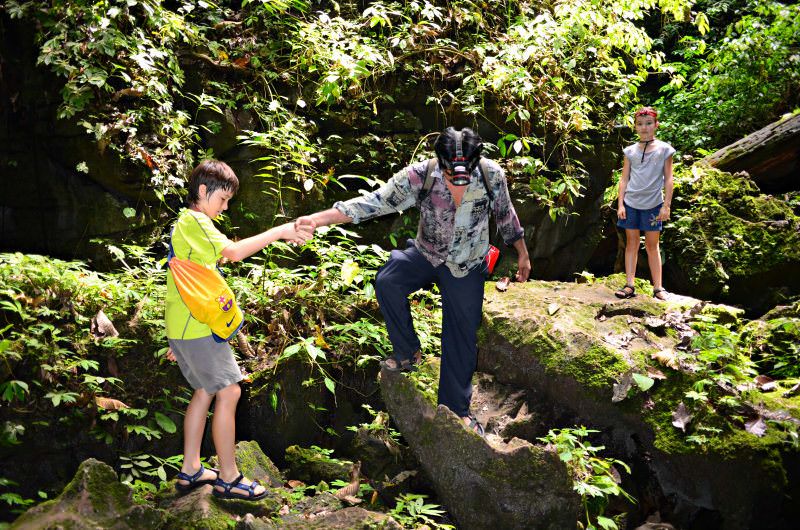
I know some people who have explored these caves without a guide. That’s completely possible. They’re not so big that a capable and athletic person could easily navigate them. However, we were glad to have a guide, because there are no footpaths, and the drop in some places is quite steep. Whether you use a guide or not, make sure to bring a headlamp or flashlight of some kind.
3. Go swimming & tubing on the Bohorok River
On most days, the river that separates the village of Bukit Lawang from Gunung Leuser National Park is clear, blue and refreshing. In fact, our family spent a lot of time in this river, jumping off the rocks and floating down its calmer patches. Our favorite place was the deepest spot just across from the Orangutan Rehabilitation Center, and we weren’t alone. More than once we were joined by various monkeys who hung out a few paces away. One afternoon, two monitor lizards crashed through the bushes, nearly slipping off a ledge and falling five feet into the water. Were they fighting? Were they mating? I don’t know, but it was certainly an unexpected show. If you’d rather socialize with fellow humans, just follow the path downriver a few hundred meters and you’ll find where the locals go for a dip.
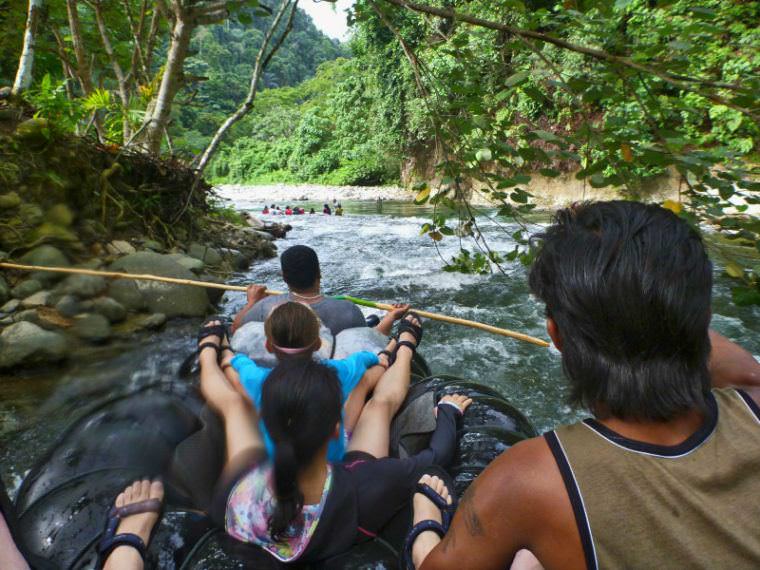
Another great water activity in Bukit Lawang is tubing. Ask at any guesthouse they’ll set you up. For a small fee, a few enterprising locals will hike upriver with you, carrying massive tubes on their heads. This hike sometimes involves crossing the river in a small, makeshift cart a few meters over the water. Once you reach a starting point, your guides deftly strap a number of these tubes together into a raft. Placing mats in the center to keep you seated, they guide you down the rapids, bamboo pole in hand to steer you through the white water.

Tubing can be done on its own, but if you’re in Bukit Lawang for a Jungle Trek, then I suggest adding tubing to the return portion of your hike. The Sumatran Rainforest is hot and muggy, and the trails are occasionally steep and slippery. After three or four hours of hiking, you’re bound to be sweaty, muddy and exhausted. Take it from us: there is no better way to end a long hot hike than stepping into the cool river to float (and splash) your way home.
4. See the sunrise from a Mount Sibayak

Four hours south of Bukit Lawang is the town of Berastagi, and this is where I’d recommend setting up a base for the next four awesome things I’m recommending. Looming over Berastagi is Mount Sibayak, a small volcano that is far from dormant. No, you won’t see lava here (at least I hope you don’t). Instead, what you can see is bubbling mud and sulfurous steam vents that are a loud as a jetliner at takeoff. Oh, and one of the most beautiful sunrises you may ever see (weather permitting).

Sumatra is warm all year round, but not so at the top of Mount Subayak. The high altitude and early hour hike mean that it’s best to carry a jacket with you. The only source of warmth up there are the sulfurous steam vents, which are essentially a bullhorn that smells like eggs
5. Take a dip in a hot spring
Mount Sibayak isn’t the only place nearby with geothermal activity going on. Seek out the hot springs near the base of the volcano. After a chilly sunrise in the clouds, it’s nice to settle into a warm bath in the sunshine.

Surprisingly, the hot spring we visited served us breakfast in the water! Expect fried rice and coffee on the menu.
6. Hike to the bottom of Supisopiso Waterfalls
This is the tallest waterfall in Indonesia and is truly a sight to see — from the top and the bottom. There is a path all the way to the bottom that is in relatively good condition. Just keep in mind that the further down you go, the cooler and more humid the air gets.
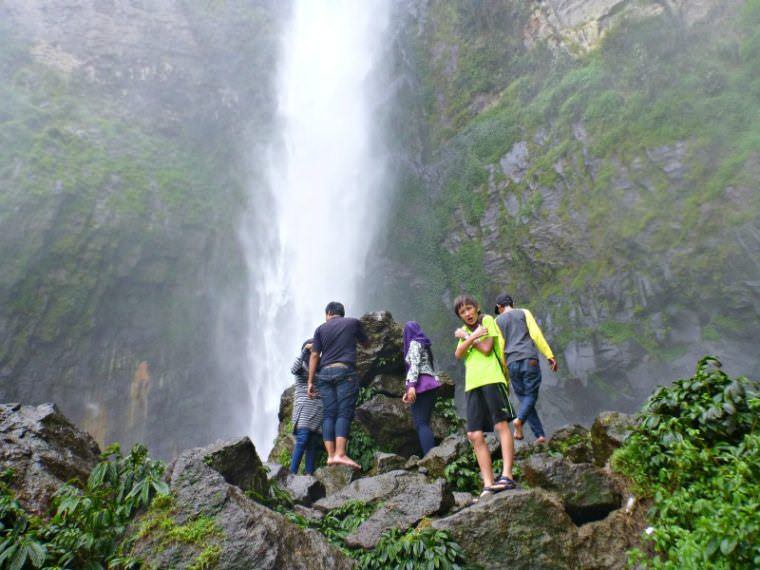
Water from the falls smashes into the rocks from 120 meters above, immediately becoming clouds of mist that race through the small and verdant valley below. There are a number of food stands and shops selling snacks to locals here, but hold out for lunch and read the next recommendation below.
7. Sample the Catch of the Day at Lake Toba
Ride further south for another superlative of the natural world. Welcome to Lake Toba: the largest volcanic lake on Earth. No, this is not hot and boiling. Instead, this cool, clear lake is what’s left after a massive volcanic explosion around 70,000 years ago. In the middle of that lake is Samosir Island. Also the result of volcanic activity, Samosir Island is a destination all its own, and home to one of the most delicious mango species we’ve ever tasted. Called “egg mangoes” because of their size and shape, my son and I ate our body weight in them.

However, that was just an appetizer. Along the shoreline of the lake, there are a number of restaurants that specialize in grilling up fish from the lake and serving them to hungry patrons. We picked out the fish ourselves. Thirty minutes later, we were digging in. Ask for the spicy sauce on the side, if you can’t take the heat. After a few fish, a few beers and a heaping plate of gado gado (boiled Indonesian vegetables with peanut sauce), we were ready for a nap. Perhaps you will be too.
8. Find accommodation in North Sumatra, Indonesia
Where to Stay in Northern Sumatra, Indonesia?
Once you leave the city of Medan, it might be best to leave your expectations of luxury hotels, as well. We’ve enjoyed nearly every place we’ve stayed Northern Sumatra, but it’s best to keep in mind that things like housekeeping, reliable electricity, and hot showers are relatively new to some areas of the island.
Best Budget Hotel in Northern Sumatra, Indonesia – Nachelle Homestay
Run by the charming couple Mery and Abdy, this is their family home. The room for rent is on the roof, and while comfortable, clean, and capable of sleeping four (possibly more), it is relatively basic. Downstairs is the living room, bathroom, and kitchen, which you share with the family.
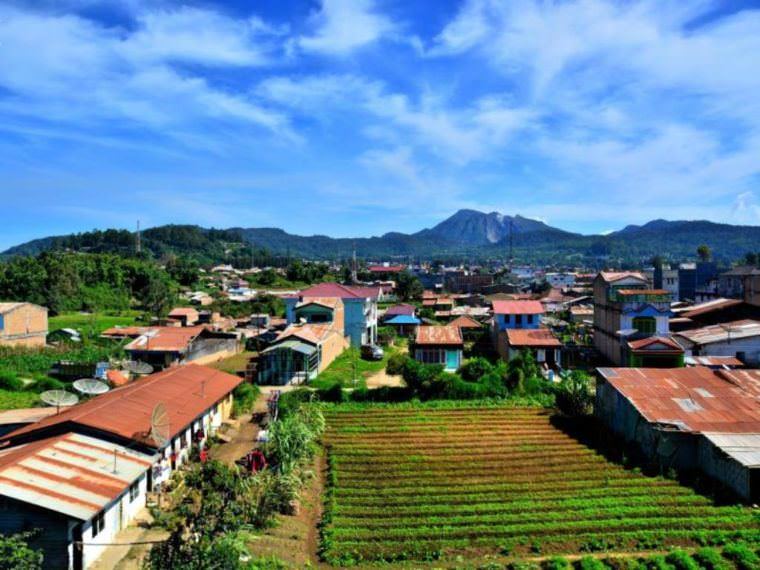
Abdy can also be hired out as a guide for the sunrise hike and other attractions. He’s funny, great with kids (he has two of them himself) and speaks fluent English and French. He also helped us arrange a driver to take us around to some of the other sites you read about above. A solid guy and I can’t recommend him enough.
Best Budget Hotel in Northern Sumatra, Indonesia – Jungle Inn
As eco tourism grows in Bukit Lawang, more and more locals are trying to get in on the action. We stayed in a number of places in the area, and our favorite was the Jungle Inn. The Jungle Inn has a number of things going for it. For one, it’s located right next to the river and right across the water from the orangutan center. That means it’s a longer walk from where drivers drop you off (this road isn’t really for cars). However, if you’re tired, you can ask one of their staff to carry you on the back of their motorcycle.
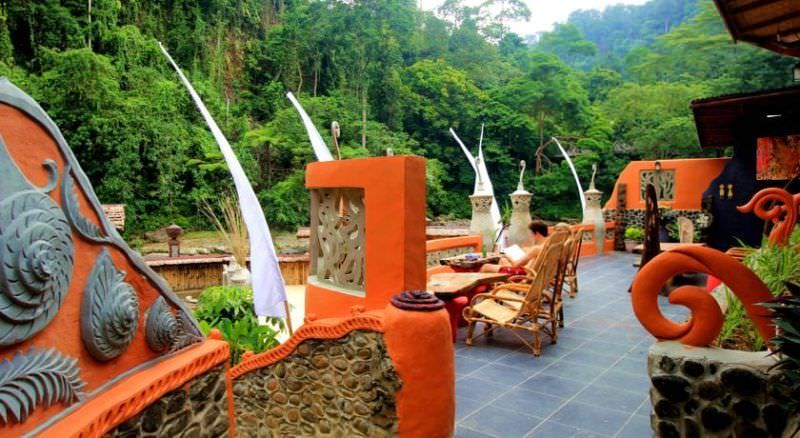
Another benefit for the Jungle Inn is that there are less mosquitoes near the water. You might want to use repellant or the nets provided when you sleep, but we were able to sit in our hammocks comfortably and play at the river’s edge for days without a single bite. Not so when we stayed away from the water further downriver.
We also had great interaction with the staff at Jungle Inn. They helped us arrange a driver to meet us at the Medan airport, and arranged our guides for jungle trekking trips and the drive onward to Berastagi.
Best Luxury Hotel in Northern Sumatra, Indonesia – D’primahotel
While the JW Marriot Hotel Medan may be the best deal for a luxury hotel anywhere in the world (seriously: USD $80 a night for something like that?), we have instead always chosen to end our Sumatran adventures at the D’Primahotel. Why? For one, the hotel is connected by closed walkway to the train platform that takes you to the airport.
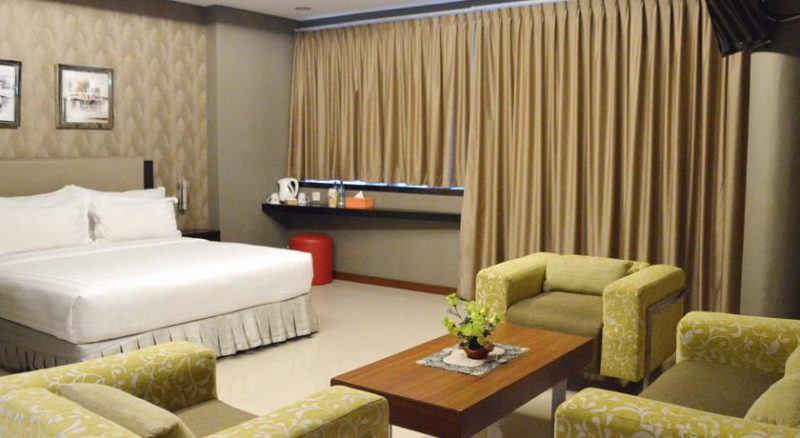
Secondly, another walkway whisks you right Center Point Mall, which has air conditioning, restaurants, and a movie theater. After a week or two in the jungle, we’ve enjoyed easing back into civilization here the night before returning home.
![]()
About the Writer
 Jason Andrew Jenkins has been living abroad since 1997 when he left the United States for a year abroad and never went back. He started a family in Japan and called Tokyo home from 2001-2013. Afterward, he and his wife left their desk jobs, pulled their kids out of school and started slow-traveling and homeschooling from place to place, living in Taiwan, Thailand, and Malaysia along the way. They are presently based in Valencia, Spain, where the kids attend local schools and speak Spanish embarrassingly better than their parents. Read more about their family travels and advice at www.AnEpicEducation.com. Prefer audio? Then listen to Jason interview other family travelers on the Epic Education Radio podcast
Jason Andrew Jenkins has been living abroad since 1997 when he left the United States for a year abroad and never went back. He started a family in Japan and called Tokyo home from 2001-2013. Afterward, he and his wife left their desk jobs, pulled their kids out of school and started slow-traveling and homeschooling from place to place, living in Taiwan, Thailand, and Malaysia along the way. They are presently based in Valencia, Spain, where the kids attend local schools and speak Spanish embarrassingly better than their parents. Read more about their family travels and advice at www.AnEpicEducation.com. Prefer audio? Then listen to Jason interview other family travelers on the Epic Education Radio podcast


